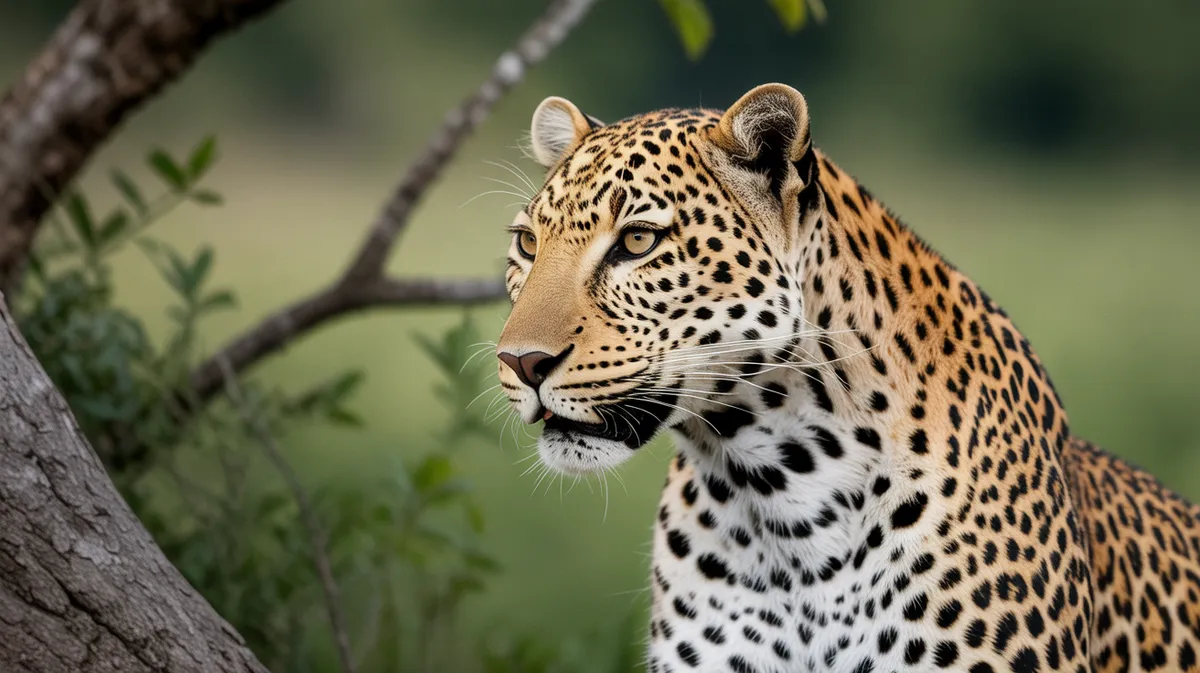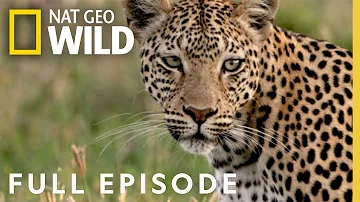
Leopard
Panthera pardus

Meet the Leopard
The leopard is a large and powerfully built feline native to Africa and parts of Asia. Distinguished by its striking golden-yellow coat patterned with black rosettes, the leopard is highly adaptable and can thrive in a wide range of habitats, from dense forests to arid savannas. Leopards are solitary and elusive by nature, rarely seen during the day as they are mainly nocturnal. They are renowned for their strength, agility, and unique ability to haul prey up into trees to avoid scavengers.
Classification
Mammal
Habitat
Forest and savanna
Diet
Carnivore
Lifespan
12-17 years
Conservation
Vulnerable
Weight
30-90 kg
📖Fascinating Facts
Tree-climbing Experts
Leopards are exceptional climbers and often rest on tree branches during the day, using the height to stay safe from other predators.
Nocturnal Hunters
They do most of their hunting at night, relying on their excellent night vision and stealth to ambush prey.
Unique Rosettes
Each leopard's pattern of spots, called rosettes, is unique, similar to human fingerprints.
📋Detailed Description
The leopard (Panthera pardus) is a medium-to-large felid characterized by a robust yet agile build, with a body length ranging from 92 to 183 cm and a tail measuring 66 to 102 cm, aiding in balance during arboreal movement. Its coat varies from pale yellowish to deep gold, densely covered with distinctive black rosettes that provide camouflage in diverse habitats. The skull is broad with strong jaw muscles, supporting a powerful bite capable of dispatching prey larger than itself. Leopards possess retractable claws and padded paws, enabling silent stalking and swift climbing. Their vision is highly adapted for nocturnal activity, with a tapetum lucidum enhancing low-light sensitivity. Solitary by nature, leopards maintain large, overlapping territories marked by scent and vocalizations. They are opportunistic carnivores, preying on over 90 species, from insects and rodents to ungulates and primates. Females exhibit strong maternal instincts, raising cubs alone in secluded dens. This species demonstrates remarkable adaptability, thriving in environments ranging from tropical rainforests and savannas to arid mountains and urban fringes. Their elusive behavior and cryptic coloration make them challenging to observe in the wild.
💡 Did you know?
A leopard can carry prey that is heavier than itself up into the branches of a tree, often more than 3 meters off the ground.
🔬Research & Sources
Wikipedia Summary
The leopard is one of the five extant cat species in the genus Panthera. It has a pale yellowish to dark golden fur with dark spots grouped in rosettes. Its body is slender and muscular reaching a length of 92–183 cm (36–72 in) with a 66–102 cm (26–40 in) long tail and a shoulder height of 60–70 cm (24–28 in). Males typically weigh 30.9–72 kg (68–159 lb), and females 20.5–43 kg (45–95 lb).
Last Modified: 6/2/2025
🎭Behavior & Social Structure
Leopards are predominantly solitary, with individuals occupying and defending territories that may overlap, especially between males and females. They are primarily nocturnal and crepuscular, hunting at dawn, dusk, and night, though in some regions with low human disturbance, they may be active during the day. Their hunting strategy involves stealthy stalking, followed by a short, explosive ambush; they kill prey with a suffocating bite to the throat or nape. Leopards are renowned for their ability to drag heavy kills—sometimes exceeding their own body weight—up into trees, a behavior that minimizes kleptoparasitism from lions, hyenas, and wild dogs. They have a broad diet, including mammals, birds, reptiles, and occasionally fish or invertebrates, and are known to cache surplus food. Social interactions are limited to mating pairs and mothers with dependent cubs. Communication includes vocalizations (rasping coughs, growls, and purrs), scent marking, and visual signals such as claw scraping.
👶Reproduction & Life Cycle
Leopards are polygynous, with no fixed breeding season in most regions, though births may peak during periods of prey abundance. Estrus in females lasts 6–7 days, during which they vocalize and scent-mark to attract males. After a gestation period of approximately 90–105 days, females give birth to 1–4 cubs (typically 2–3) in a secluded den, such as a cave, dense thicket, or hollow tree. Cubs are born blind and helpless, weighing 400–600 grams, and open their eyes after 7–10 days. The mother frequently moves the cubs to new hiding spots to avoid predation. Cubs are weaned at 3 months but remain dependent for up to 18–24 months, learning hunting skills through observation and play. Male leopards do not participate in parental care. Juvenile mortality is high, primarily due to predation by lions, hyenas, and other leopards.
🛡️Adaptations & Survival
Leopards exhibit a suite of adaptations for survival in varied environments. Their cryptic rosette-patterned coat provides camouflage in dappled light, while their muscular limbs and flexible spine enable powerful leaps and agile climbing. Retractable claws and rough tongue papillae assist in gripping prey and feeding. Their acute hearing and night vision facilitate nocturnal hunting. Behavioral flexibility allows them to exploit a wide range of prey and habitats, including proximity to human settlements. They are capable swimmers and can cross rivers or hunt aquatic prey. The ability to cache food in trees or dense cover is a key evolutionary specialization, reducing competition with larger carnivores.
🎨Cultural Significance
Leopards have held symbolic significance in many cultures, often representing strength, stealth, and nobility. In African folklore, they are revered as cunning and powerful animals, sometimes associated with royalty or spiritual guardianship. In ancient Egypt, leopard skins were worn by priests as symbols of power. In Asian cultures, leopards feature in myths and are sometimes depicted as protectors or omens. Their pelts and body parts have been used in traditional medicine and ceremonial attire. The leopard's image is widely used in heraldry, art, and modern branding, reflecting its enduring cultural resonance.
🔬Recent Research & Discoveries
Recent genetic studies have clarified the taxonomy of leopards, revealing nine extant subspecies with significant genetic divergence, particularly among Asian populations. Camera trap surveys and GPS collaring have improved understanding of leopard ecology, movement patterns, and habitat use, especially in fragmented landscapes. Research on human-leopard conflict mitigation has led to community-based conservation initiatives and improved livestock management practices. Studies on leopard vocalizations and scent marking are shedding light on their communication systems. Conservation genetics is being employed to assess population connectivity and inform translocation or reintroduction programs for critically endangered subspecies.
🎥Wildlife Videos

Secret Hunters - The Leopards of Dead Tree Island | Free Documentary Nature
Secret Hunters - The Leopards of Dead Tree Island | Wildlife Documentary Watch 'The Last Lion of the Liuwa Plain' here: ...
Free Documentary - Nature

Following the Jade Eyed Leopard (Full Episode SPECIAL) | Nat Geo Wild
In Jade Eyed Leopard, follow Toto, a leopard with unusual aquamarine eyes, for the first years of her life as she learns ...
Nat Geo Animals

Leopard's Rock (Full Episode) | Savage Kingdom
Saba the leopard is a killer without rival. She haunts the trees and hills in the heart of the kingdom. There is no question that Saba ...
Nat Geo Animals

Life in the Serengeti: The Leopardess - Queen of the Savanna | Full Documentary
The Serengeti and its labyrinth of gallery forests are the home of a leopardess. To her family she is both caring provider and ...
Free High-Quality Documentaries

Kruger National Park's Best Kept Secret: Leopard Behavior Revealed | Wild Animal Documentary
Kruger National Park's Best Kept Secret: Leopard Behavior Revealed | Wild Animal Documentary Dive into the mysterious life of ...
NAV - Wild Animal Documentary

World's Largest Leopard Stalks Prey | Wild Sri Lanka: Realm of the Leopard
In certain parts of Sri Lanka, the apex predator is the Sri Lankan leopard. As in neighbouring India, deforestation has diminished ...
Love Nature
🌍Habitat Information
The Leopard typically inhabits Forest and savanna environments. Leopards have adapted to their environments with specialized features and behaviors.
Primary Habitat:
Forest and savanna
More detailed habitat information will be available soon.
🛡️Conservation Status
The Leopard is currently classified as Vulnerable. Conservation efforts are crucial for preserving this species for future generations.
Common Threats:
- 🏠Habitat loss and fragmentation
- 🌡️Climate change impacts
- 🎯Hunting and poaching
- 🏭Human-wildlife conflict
⚠️Threats & Conservation Challenges
Leopards face significant threats from habitat loss, fragmentation, and degradation due to agricultural expansion, urbanization, and infrastructure development. Human-leopard conflict arises from livestock predation, leading to retaliatory killings. Illegal hunting for skins, bones, and body parts for traditional medicine and the wildlife trade poses a major threat, especially in Asia. Depletion of natural prey due to overhunting and competition with other large carnivores further impacts populations. Road mortality and disease transmission from domestic animals are emerging concerns. The IUCN Red List classifies the leopard as Vulnerable, with some subspecies (e.g., the Amur, Arabian, and Javan leopards) listed as Critically Endangered. Population trends are declining in most of the species' range, with local extinctions reported in parts of North Africa, the Middle East, and Southeast Asia.
🔬Scientific Classification
Scientific Name
Panthera pardus
Classification Hierarchy
🔍 About Taxonomic Classification
Taxonomic classification is a hierarchical system used by scientists to classify and organize living organisms based on shared characteristics and evolutionary relationships.
The system moves from broad categories (Kingdom) to increasingly specific ones, with each animal's scientific name typically consisting of its Genus and species.
📝Community Notes
Share your observations and insights about the Leopard with our community of wildlife enthusiasts.
Join Our Community
Sign in to share your observations and connect with fellow wildlife enthusiasts.
Sign In to ContributeNo community notes yet
Be the first to share your observations about the Leopard!
Explore Leopard
Select a tab above to learn more about this amazing animal.
📸Photo Gallery
No photos available for this animal yet.
🌟Discover More Wildlife
Continue your journey of discovery with more fascinating animals from our database
